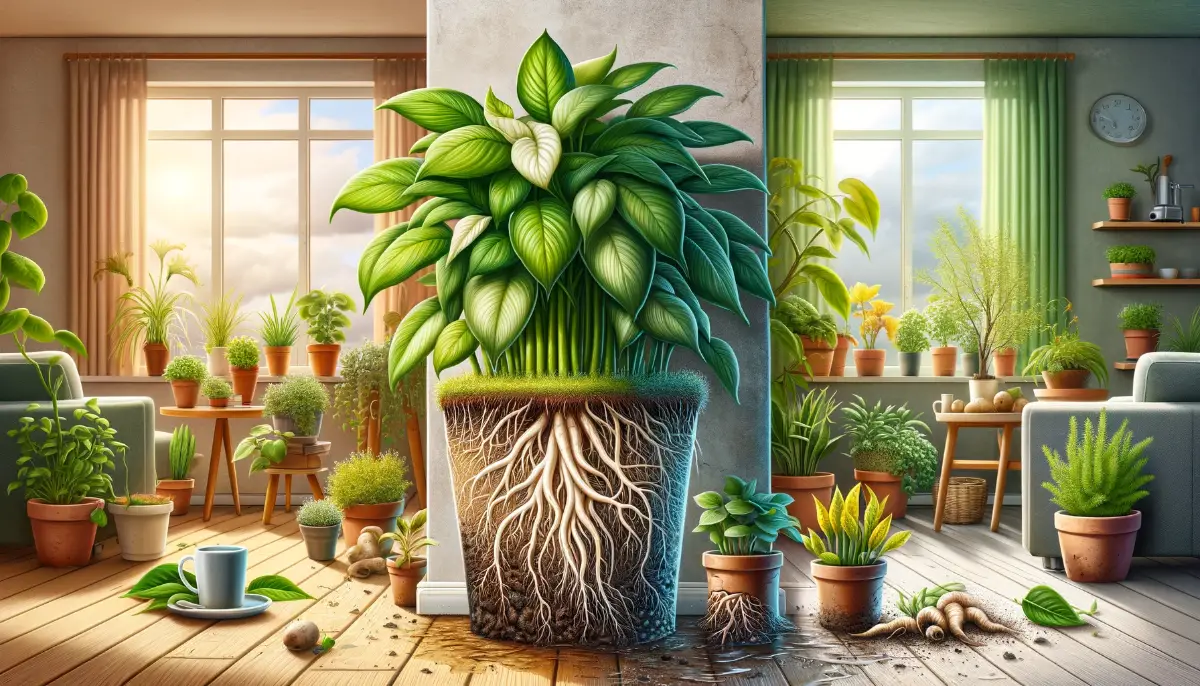Chrysanthemums, commonly known as mums, are a cherished choice for indoor plant enthusiasts, valued for their vibrant blossoms and versatile nature.
These plants, which originally hail from East Asia and northeastern Europe, have captivated gardeners and decorators around the world with their wide array of colors and forms.
Whether you’re looking to brighten up your living space or add a touch of nature to your office, chrysanthemums offer a stunning range of options—from the classic shades of yellow and white to bold reds and purples.
Their popularity is not only due to their aesthetic appeal but also their ability to thrive indoors with the right care, making them an excellent addition to any indoor garden.
Optimal Growing Conditions for Indoor Chrysanthemums
Chrysanthemums thrive indoors under the right conditions, which largely mirror their natural outdoor environment but with controlled elements to enhance their growth and bloom. Here’s how to create the optimal indoor setting for your chrysanthemums:
Light
Chrysanthemums require bright, indirect sunlight to flourish. Position them near a window that receives ample light but is shielded from direct midday sun, which can scorch their leaves. If natural light is insufficient, especially during shorter winter days, consider using a grow light placed about 6 inches above the plant to simulate the necessary photoperiod needed for flowering.
Temperature and Humidity
These plants prefer cooler temperatures and moderate humidity, ideally between 10°C and 18°C (50°F and 65°F). Such conditions help prolong the bloom period and maintain the vibrancy of the flowers. Avoid placing mums near heat sources like radiators or air conditioning vents, as these can disrupt their growth cycle and cause premature wilting.
Air Circulation
Good air circulation is crucial to prevent pest infestations and diseases. However, ensure the airflow is not too strong as it could dry out the plants too quickly. A gentle, indirect breeze can help mimic the natural outdoor conditions that mums find ideal.
By meeting these conditions, your indoor chrysanthemums can become a spectacular highlight in your home, showcasing their beauty and color variety effectively.
Planting and Repotting Tips
Planting and repotting chrysanthemums indoors involves careful attention to their root and soil needs to ensure healthy growth and abundant flowering. Here are some essential tips for planting and repotting your indoor chrysanthemums:
Choosing the Right Soil
Chrysanthemums thrive in rich, well-draining soil. A good potting mix for chrysanthemums would typically include components like peat moss, perlite, and vermiculite, which help in retaining moisture while also providing adequate drainage.
Ensuring the soil is loose and fertile is key to allowing the roots to spread out and absorb nutrients efficiently.
Selecting Containers
When choosing a container for your chrysanthemums, ensure it has enough room for growth and proper drainage holes to prevent waterlogging, which can lead to root rot. Chrysanthemums do well in containers that are wider than they are deep, as their roots tend to spread horizontally rather than deeply.
Planting Procedure
When planting chrysanthemums, ensure the top of the root ball is even with the soil surface. After placing the plant in the pot, fill around the roots gently with soil without compressing it too much.
This allows for better air circulation around the roots. Water the plant thoroughly after planting to help settle the soil around the roots and eliminate any air pockets.
Repotting Tips
Chrysanthemums should be repotted when they outgrow their current pot or when the soil has become compacted and nutrient-deficient. Repotting is best done in the spring before the new growth starts.
When repotting, choose a new pot that is one size larger than the current one to give the roots ample room to grow. Use fresh potting mix and make sure to handle the root ball gently to avoid damage.
By following these planting and repotting tips, you can help ensure your indoor chrysanthemums are healthy and vibrant, ready to brighten up your indoor spaces with their colorful blooms.
Watering Practices
Effective watering practices are crucial for maintaining healthy chrysanthemums indoors. Here are some tips based on organic gardening principles:
Water Deeply but Infrequently
Chrysanthemums benefit from deep watering, which encourages the roots to grow deeper into the soil. This makes the plants more resilient and better able to access nutrients and moisture.
Water the plants thoroughly, allowing the water to penetrate several inches into the soil. Allow the top layer of soil to dry out before the next watering to encourage healthy root growth and prevent root rot.
Morning Watering
Water your chrysanthemums early in the morning. This timing helps ensure that the water has time to soak deeply into the soil before temperatures rise, which can increase evaporation.
Additionally, watering in the morning helps keep the foliage dry throughout the day, reducing the risk of fungal diseases.
Check Soil Moisture Regularly : Before watering, check the soil moisture by sticking your finger into the soil up to the second knuckle. If the soil at that depth feels dry, it’s time to water.
This method helps prevent over-watering, which is a common issue in indoor gardening and can lead to root diseases
Adjust Watering Based on Seasonal Changes
Be mindful of the changing seasons and adjust your watering accordingly. Indoor air can become drier in the winter due to heating, which might require more frequent watering. Conversely, in the humid summer months, you may need to water less frequently.
These watering practices will help you maintain robust chrysanthemums that are well-prepared to produce beautiful blooms. Remember, consistent care is key to the health and longevity of your indoor plants.
Adopting an organic approach to watering and fertilizing chrysanthemums can enhance their growth and blooming while being environmentally friendly. Here are some effective strategies to consider:
Organic Fertilization Techniques
- Compost: Incorporate well-rotted compost into the soil at planting time and as a top dressing during the growing season. Compost provides a slow-release source of nutrients, which is ideal for chrysanthemums and enhances soil structure and fertility.
- Organic Fertilizers: Choose organic fertilizers that are rich in phosphorus to promote blooming. Bone meal is a great option as it slowly releases phosphorus, which is essential for flower production. Be mindful of the nitrogen content; excessive nitrogen can lead to lush foliage at the expense of blooms.
- Liquid Seaweed: Use liquid seaweed as a foliar spray or soil drench. It’s rich in trace elements and natural growth hormones, which can help boost flower production and enhance overall plant health.
By following these organic watering and fertilization strategies, you not only support the health and vibrancy of your chrysanthemums but also contribute to a more sustainable gardening practice.
Pruning and Maintenance
Pruning and maintenance are key components of caring for indoor chrysanthemums, helping to ensure they remain healthy and bloom beautifully. Here’s a guide on how to effectively prune and maintain your chrysanthemums:
Pruning Techniques
- Pinching: Start pinching the growing tips of your chrysanthemums when they are about 6 inches tall. This encourages the plant to branch out, leading to a fuller appearance and more blooms. Continue to pinch back the tips every few weeks until mid-summer to maximize branching and flowering.
- Deadheading: Regularly remove spent flowers (deadheading) to encourage the plant to produce more blooms. This not only extends the blooming period but also keeps the plant looking neat and tidy.
- Cutting Back: After the blooming season, cut back the stems to about 6 inches above the soil line. This helps the plant conserve energy over the winter and can lead to more vigorous growth in the following season.
Maintenance Practices
- Regular Inspection: Regularly inspect your plants for signs of pests or disease. Early detection is crucial for effective treatment and can prevent minor issues from becoming major problems.
- Cleaning Foliage: Keep the leaves of your chrysanthemums clean by gently wiping them with a damp cloth. This removes dust and helps prevent the buildup of pests and diseases.
- Staking: For taller varieties of chrysanthemums, consider staking them to provide support and maintain their shape. Use soft ties to secure the stems to stakes, avoiding any damage to the plant .
By adhering to these pruning and maintenance practices, you can help your indoor chrysanthemums stay vibrant and floriferous. Regular care not only enhances the aesthetic appeal of these plants but also contributes to their overall health and longevity.
Propagation Methods
Propagating chrysanthemums is a rewarding way to expand your collection and share these beautiful plants with friends and family. Here are some common methods of propagating chrysanthemums:
Division:
- Timing: Division is best done in the early spring when new shoots are starting to appear but are still small.
- Process: Carefully dig up the entire plant, and using a sharp knife or spade, divide the root clump into smaller sections, making sure each section has several shoots and a good portion of roots. Replant immediately in well-prepared soil.
Cuttings:
- Timing: Cuttings can be taken in spring or early summer.
- Process: Use a sharp, clean knife or scissors to take cuttings about 4 to 6 inches long. Make sure each cutting has at least one set of leaves. Dip the cut end into rooting hormone to encourage root growth. Plant the cuttings in a moist, well-draining potting mix, ensuring at least one node (where leaves attach) is below the surface. Keep the soil consistently moist and cover with a plastic bag or dome to retain humidity until roots develop.
Seeds:
- Consideration: While not the most common method for propagating chrysanthemums, growing from seeds is possible but typically does not result in plants true to the parent’s characteristics.
- Process: Sow seeds in a tray of well-draining seed starting mix. Cover lightly with soil and keep moist. Germination usually occurs within two weeks under optimal temperature conditions. Once seedlings are large enough to handle, transplant them into individual pots.
These methods allow gardeners to effectively increase their chrysanthemum collection, ensuring a steady supply of these colorful flowers for indoor and outdoor enjoyment.
Common Pests and Diseases
Chrysanthemums, while relatively easy to care for, can be susceptible to a range of pests and diseases. It’s important to monitor your plants regularly and take prompt action to mitigate any issues. Here are some common pests and diseases that affect chrysanthemums:
Pests:
- Aphids: These small, sap-sucking insects cluster on new growth and the undersides of leaves, excreting sticky honeydew that can lead to sooty mold. A strong water spray or insecticidal soap can effectively control aphids.
- Spider Mites: These tiny pests cause yellow speckling on leaves and can spin fine webs around the plant material. Increasing humidity and using miticides can help manage spider mite infestations.
- Thrips: These insects can cause distorted leaves and discolored flowers. Thrips are challenging to see but can be managed with appropriate insecticidal sprays.
Diseases:
- Powdery Mildew: Appears as a white or grayish powder on leaves and stems, particularly under humid conditions. Ensure good air circulation and consider using fungicides if necessary.
- Botrytis Blight: This fungus causes brown spots on leaves and blooms, especially in cool, wet conditions. Remove affected parts and improve air circulation to prevent its spread.
- Root Rot: Overwatering can lead to root rot, characterized by blackened, mushy roots and a generally unhealthy plant. Ensure proper drainage and avoid overwatering to prevent this condition.
Preventative measures such as proper spacing, adequate ventilation, and avoiding overhead watering are essential in maintaining the health of your chrysanthemums. Regularly inspecting your plants and addressing issues early can help ensure your chrysanthemums remain vibrant and healthy.
FAQs on Growing and Caring for Chrysanthemums indoors
How often should I water indoor chrysanthemums?
Water your chrysanthemums when the top inch of the soil feels dry. Generally, this means watering deeply once a week, but adjust based on temperature and humidity levels.
What type of light is best for growing chrysanthemums indoors?
Chrysanthemums thrive in bright, indirect sunlight. A spot near a window that gets several hours of light but is shielded from direct midday sun is ideal.
Do indoor chrysanthemums need special soil?
Yes, use a well-draining potting mix enriched with organic matter. A mix of peat, perlite, and compost works well for chrysanthemums.
How can I encourage my chrysanthemum to bloom indoors?
Ensure adequate light, keep the temperature cooler (around 65°F), and use a high-phosphorus fertilizer to encourage blooming.
Can I use tap water to water my chrysanthemums?
Yes, tap water is generally fine, but let it sit overnight to allow chlorine to evaporate if your tap water is heavily treated.
How do I prune indoor chrysanthemums?
Pinch back the growing tips when plants are young to encourage bushiness. Regularly deadhead spent flowers to promote more blooms.
What common pests should I watch out for?
Aphids, spider mites, and thrips are common. Check regularly and treat with insecticidal soap or neem oil if you spot these pests.
How do I repot a chrysanthemum?
Repot in the spring before new growth starts. Choose a slightly larger pot with good drainage and fresh potting soi.
Are chrysanthemums good air purifiers?
Yes, chrysanthemums are known to help purify indoor air by removing toxins such as benzene and formaldehyde.
Can I move my indoor chrysanthemum outdoors?
Yes, but acclimate it slowly to outdoor conditions in the spring to prevent shock. Ensure it’s placed in a similarly bright location with protection from the hottest sun.










